The 3D Multifractal Characteristics of Urban Morphology in Chinese Old Districts
Abstract
1. Introduction
2. Materials and Methods
2.1. Study Area
2.2. Data Source
2.3. Cross-Scale 3D Units
2.4. Multifractal Feature Verification Method
2.5. Multifractal Measurement and Its Morphological Implications
2.6. Map Matrix Based on 3D Units Mapping
3. Results
3.1. Measurement Results of Multifractal Indicators
3.2. The Analysis of the Generalized Dimension Spectrum
3.3. The Analysis of the 3D Map Matrix
4. Discussion
4.1. Fluctuation Changes of the Generalized Dimension Spectrum
4.2. The Dimensional Relationship Between 3D and 2D
4.3. Growth Mechanism of 3D Morphological Structure
4.4. Urban Morphological Development Suggestions for Chinese Old Districts
4.5. Limitations and Future Studies
5. Conclusions
Supplementary Materials
Author Contributions
Funding
Data Availability Statement
Conflicts of Interest
References
- Liu, H. Research of the Morphological Types of Blocks in the Old City of Nanjing. In Proceedings of the 24th ISUF 2017—City and Territory in the Globalization Age Spain, Valencia, Spain, 27–29 September 2017. [Google Scholar] [CrossRef]
- Song, Y.; Pang, Y. Measuring the Superblock Based on a Hierarchy Matrix of Geometry, Configuration, Network, and Area: The Case of Nanjing. Environ. Plan. B-Urban Anal. City Sci. 2023, 50, 1057–1071. [Google Scholar] [CrossRef]
- Zhang, L.; Ding, W. Changing Urban Form in a Planned Economy: The Case of Nanjing. Urban Morphol. 2018, 22, 15–34. [Google Scholar] [CrossRef]
- Conzen, M.P.; Gu, K.; Whitehand, J.W.R. Comparing Traditional Urban Form in China and Europe: A Fringe-Belt Approach. Urban Geogr. 2012, 33, 22–45. [Google Scholar] [CrossRef]
- Lagarias, A.; Prastacos, P. Comparing the Urban Form of South European Cities Using Fractal Dimensions. Environ. Plan. B-Urban Anal. City Sci. 2020, 47, 1149–1166. [Google Scholar] [CrossRef]
- Qiao, W.; Wang, Y.; Ji, Q.; Hu, Y.; Ge, D.; Cao, M. Analysis of the Evolution of Urban Three-Dimensional Morphology: The Case of Nanjing City, China. J. Maps 2019, 15, 30–38. [Google Scholar] [CrossRef]
- Ge, X.; Han, D. Sustainability-Oriented Configurational Analysis of the Street Network of China’s Superblocks: Beyond Marshall’s Model. Front. Archit. Res. 2020, 9, 858–871. [Google Scholar] [CrossRef]
- Chen, Y.; Huang, L. Modeling Growth Curve of Fractal Dimension of Urban Form of Beijing. Physica A 2019, 523, 1038–1056. [Google Scholar] [CrossRef]
- Song, Y.; Zhang, Y.; Han, D. Deciphering Built Form Complexity of Chinese Cities through Plot Recognition: A Case Study of Nanjing, China. Front. Archit. Res. 2022, 11, 795–805. [Google Scholar] [CrossRef]
- Gao, C.; Lu, H.; Ding, W.; Larkham, P.J. The Relationship between Urban Form and Land-Use Regulation in China: The Case of Nanjing. Urban Morphol. 2024, 28, 3–26. [Google Scholar] [CrossRef]
- Liu, J.; Deguchi, A. The Mechanism of Block Form Diversification in Urban Morphological Transformation: Case Study of Grid Blocks in Beijing, China. Front. Archit. Res. 2024, 13, 928–943. [Google Scholar] [CrossRef]
- Cai, Z.; Demuzere, M.; Tang, Y.; Wan, Y. The Characteristic and Transformation of 3D Urban Morphology in Three Chinese Mega-Cities. Cities 2022, 131, 103988. [Google Scholar] [CrossRef]
- Frolking, S.; Mahtta, R.; Milliman, T.; Esch, T.; Seto, K.C. Global Urban Structural Growth Shows a Profound Shift from Spreading out to Building Up. Nat. Cities 2024, 1, 555–566. [Google Scholar] [CrossRef]
- Zhang, Y.; Luo, F.; Dai, Y.; Zhang, C. Changing Spatial Inclusion of Migrants in Chinese Cities: How Housing Matters. Habitat Int. 2025, 157, 103319. [Google Scholar] [CrossRef]
- Dong, J.; Guo, R.; Guo, F.; Cai, J. Potential Evaluation and Implementation Strategy for Pocket Park Construction in High-Density Urban Areas: A Case Study in Dalian, China. Front. Archit. Res. 2024, 13, 319–334. [Google Scholar] [CrossRef]
- Es-sakali, N.; Pfafferott, J.; Mghazli, M.O.; Cherkaoui, M. Towards Climate-Responsive Net Zero Energy Rural Schools: A Multi-Objective Passive Design Optimization with Bio-Based Insulations, Shading, and Roof Vegetation. Sustain. Cities Soc. 2025, 120, 106142. [Google Scholar] [CrossRef]
- He, X.; Zhou, Y. Urban Spatial Growth and Driving Mechanisms under Different Urban Morphologies: An Empirical Analysis of 287 Chinese Cities. Landsc. Urban Plan. 2024, 248, 105096. [Google Scholar] [CrossRef]
- Shi, B.; Yang, J. Scale, Distribution, and Pattern of Mixed Land Use in Central Districts: A Case Study of Nanjing, China. Habitat Int. 2015, 46, 166–177. [Google Scholar] [CrossRef]
- Zhang, C.; Ping, X.; Fan, Q.; Li, C. Measurement of 2D and 3D Fractal Features of Urban Morphology from an Architectural View and Its Influencing Factors. Fractal Fract. 2024, 8, 138. [Google Scholar] [CrossRef]
- Batty, M.; Longley, P. Fractal Cities—A Geometry of Form and Function; Academic Press Professional, Inc.: San Diego, CA, USA, 1994. [Google Scholar] [CrossRef]
- Batty, M. The Size, Scale, and Shape of Cities. Science 2008, 319, 769–771. [Google Scholar] [CrossRef]
- Tan, X.; Huang, B.; Batty, M.; Li, J. Urban Spatial Organization, Multifractals, and Evolutionary Patterns in Large Cities. Ann. Am. Assoc. Geogr. 2021, 111, 1539–1558. [Google Scholar] [CrossRef]
- Zhang, C.; Shao, D.; Yang, J.; Liu, X. A Multifractal Method Based on Spacematrix Type Units for Analysing Cross-Scale Characteristics of Urban Morphology. Front. Archit. Res. 2024; in press. [Google Scholar] [CrossRef]
- Chen, Y.; Wang, J. Multifractal Characterization of Urban Form and Growth: The Case of Beijing. Environ. Plan. B-Plan. Des. 2013, 40, 884–904. [Google Scholar] [CrossRef]
- Mandelbrot, B. How Long Is the Coast of Britain? Statistical Self-Similarity and Fractional Dimension. Science 1967, 156, 636–638. [Google Scholar] [CrossRef] [PubMed]
- Mandelbrot, B. The Fractal Geometry of Nature; W. H. Freeman and Company: New York, NY, USA, 1983. [Google Scholar]
- Viczek, T. Fractal Growth Phenomena, 1st ed.; World Scientific: Singapore, 1989; pp. 19–24. [Google Scholar]
- Ma, D.; Guo, R.; Zheng, Y.; Zhao, Z.; He, F.; Zhu, W. Understanding Chinese Urban Form: The Universal Fractal Pattern of Street Networks over 298 Cities. ISPRS Int. J. Geo-Inf. 2020, 9, 192. [Google Scholar] [CrossRef]
- Cao, W.; Dong, L.; Wu, L.; Liu, Y. Quantifying Urban Areas with Multi-Source Data Based on Percolation Theory. Remote Sens. Environ. 2020, 241, 111730. [Google Scholar] [CrossRef]
- Frankhauser, P.; Tannier, C.; Vuidel, G.; Houot, H. An Integrated Multifractal Modelling to Urban and Regional Planning. Comput. Environ. Urban Syst. 2018, 67, 132–146. [Google Scholar] [CrossRef]
- Murcio, R.; Masucci, A.P.; Arcaute, E.; Batty, M. Multifractal to Monofractal Evolution of the London Street Network. Phys. Rev. E 2015, 92, 062130. [Google Scholar] [CrossRef]
- Fan, Q.; Mei, X.; Zhang, C.; Yang, X. Research on Gridding of Urban Spatial Form Based on Fractal Theory. ISPRS Int. J. Geo-Inf. 2022, 11, 622. [Google Scholar] [CrossRef]
- Bruyns, G.J.; Higgins, C.D.; Nel, D.H. Urban Volumetrics: From Vertical to Volumetric Urbanisation and Its Extensions to Empirical Morphological Analysis. Urban Stud. 2021, 58, 922–940. [Google Scholar] [CrossRef]
- Zhao, F.; Liu, J.; Zhou, Y. Sandbox Edge-Based Algorithm for Multifractal Analysis of Complex Networks. Chaos Solitons Fractals 2023, 173, 113719. [Google Scholar] [CrossRef]
- Wang, J.; Lu, F.; Liu, S. A Classification-Based Multifractal Analysis Method for Identifying Urban Multifractal Structures Considering Geographic Mapping. Comput. Environ. Urban Syst. 2023, 101, 101952. [Google Scholar] [CrossRef]
- Man, X.; Chen, Y. Fractal-Based Modeling and Spatial Analysis of Urban Form and Growth: A Case Study of Shenzhen in China. ISPRS Int. J. Geo-Inf. 2020, 9, 672. [Google Scholar] [CrossRef]
- Whitehand, J.; Gu, K. Urban Fringe Belts: Evidence from China. Environ. Plan. B-Urban Anal. City Sci. 2017, 44, 80–99. [Google Scholar] [CrossRef]
- Cao, J.; Zhu, J.; Zhang, Q.; Wang, K.; Yang, J.; Wang, Q. Modeling Urban Intersection Form: Measurements, Patterns, and Distributions. Front. Archit. Res. 2021, 10, 33–49. [Google Scholar] [CrossRef]
- Niu, Y.; Mi, X.; Wang, Z. Vitality Evaluation of the Waterfront Space in the Ancient City of Suzhou. Front. Archit. Res. 2021, 10, 729–740. [Google Scholar] [CrossRef]
- Chen, Y.; Feng, J. Spatial Analysis of Cities Using Rényi Entropy and Fractal Parameters. Chaos Solitons Fractals 2017, 105, 279–287. [Google Scholar] [CrossRef]
- Saeedimoghaddam, M.; Stepinski, T.F.; Dmowska, A. Rényi’s Spectra of Urban Form for Different Modalities of Input Data. Chaos Solitons Fractals 2020, 139, 109995. [Google Scholar] [CrossRef]
- Chen, Y.; Wang, J.; Feng, J. Understanding the Fractal Dimensions of Urban Forms through Spatial Entropy. Entropy 2017, 19, 600. [Google Scholar] [CrossRef]
- Saeedimoghaddam, M.; Stepinski, T.F. Multiplicative Random Cascade Models of Multifractal Urban Structures. Physica A 2021, 569, 125767. [Google Scholar] [CrossRef]
- Long, Y.; Chen, Y. Multifractal Scaling Analyses of Urban Street Network Structure: The Cases of Twelve Megacities in China. PLoS ONE 2021, 16, e0246925. [Google Scholar] [CrossRef]
- Wang, P.; Gu, C.; Yang, H.; Wang, H. The Multi-Scale Structural Complexity of Urban Morphology in China. Chaos Solitons Fractals 2022, 164, 112721. [Google Scholar] [CrossRef]
- Witten, T.A.; Sander, L.M. Diffusion-Limited Aggregation, a Kinetic Critical Phenomenon. Phys. Rev. Lett. 1981, 47, 1400–1403. [Google Scholar] [CrossRef]
- Batty, M. Cities as Fractals: Simulating Growth and Form. In Fractals and Chaos; Crilly, A.J., Earnshow, R.A., Jones, H., Eds.; Springer: New York, NY, USA, 1991; pp. 43–69. [Google Scholar]
- Conzen, M.P. How Cities Internalize Their Former Urban Fringes: A Cross-Cultural Comparison. Urban Morphol. 2009, 13, 29–54. [Google Scholar] [CrossRef]
- Chen, Y.; Wu, M. Analyzing Recent Morphological Evolution in Central Beijing during Relocating Non-Capital Functions Based on POI Data and Digital Maps. Cities Assem. 2022, 3, 101–113. [Google Scholar] [CrossRef]
- Li, Z.; Xu, Y.; Bai, X.; Xu, Z.; Ma, H.; Yue, X.; Liu, J.; Lun, Y. Study on the Relationship between Urban Road Network Morphology and Spatial Distribution of Hotel Industry: A Case Study of Nanjing City. Environ. Dev. Sustain. 2025, 27, 2423–2447. [Google Scholar] [CrossRef]
- Li, J.; Li, C.; Zhu, F.; Song, C.; Wu, J. Spatiotemporal Pattern of Urbanization in Shanghai, China between 1989 and 2005. Landsc. Ecol. 2013, 28, 1545–1565. [Google Scholar] [CrossRef]
- Xiong, W.; Yang, J. Delineating and Characterizing the Metropolitan Fringe Area of Shanghai—A Spatial Morphology Perspective. Land 2023, 12, 2086. [Google Scholar] [CrossRef]
- Sharifi, A. Resilient Urban Forms: A Macro-Scale Analysis. Cities 2019, 85, 1–14. [Google Scholar] [CrossRef]
- Whitehand, J.W.R.; Gu, K.; Whitehand, S.M. Fringe Belts and Socioeconomic Change in China. Environ. Plan. B 2011, 38, 41–60. [Google Scholar] [CrossRef]
- Wang, S.; Gu, K. Pingyao: The Historic Urban Landscape and Planning for Heritage-Led Urban Changes. Cities 2020, 97, 102489. [Google Scholar] [CrossRef]
- Zhou, L.; Gong, Y.; López-Carr, D.; Huang, C. A Critical Role of the Capital Green Belt in Constraining Urban Sprawl and Its Fragmentation Measurement. Land Use Policy 2024, 141, 107148. [Google Scholar] [CrossRef]
- Zhou, L.; Wei, L.; López-Carr, D.; Dang, X.; Yuan, B.; Yuan, Z. Identification of Irregular Extension Features and Fragmented Spatial Governance within Urban Fringe Areas. Appl. Geogr. 2024, 162, 103172. [Google Scholar] [CrossRef]
- Wang, H. The Role of Informal Ruralization within China’s Rapid Urbanization. Nat. Cities 2024, 1, 205–215. [Google Scholar] [CrossRef]
- Zhu, Z.; Zhou, Y.; Seto, K.C.; Stokes, E.C.; Deng, C.; Pickett, S.T.A.; Taubenböck, H. Understanding an Urbanizing Planet: Strategic Directions for Remote Sensing. Remote Sens. Environ. 2019, 228, 164–182. [Google Scholar] [CrossRef]

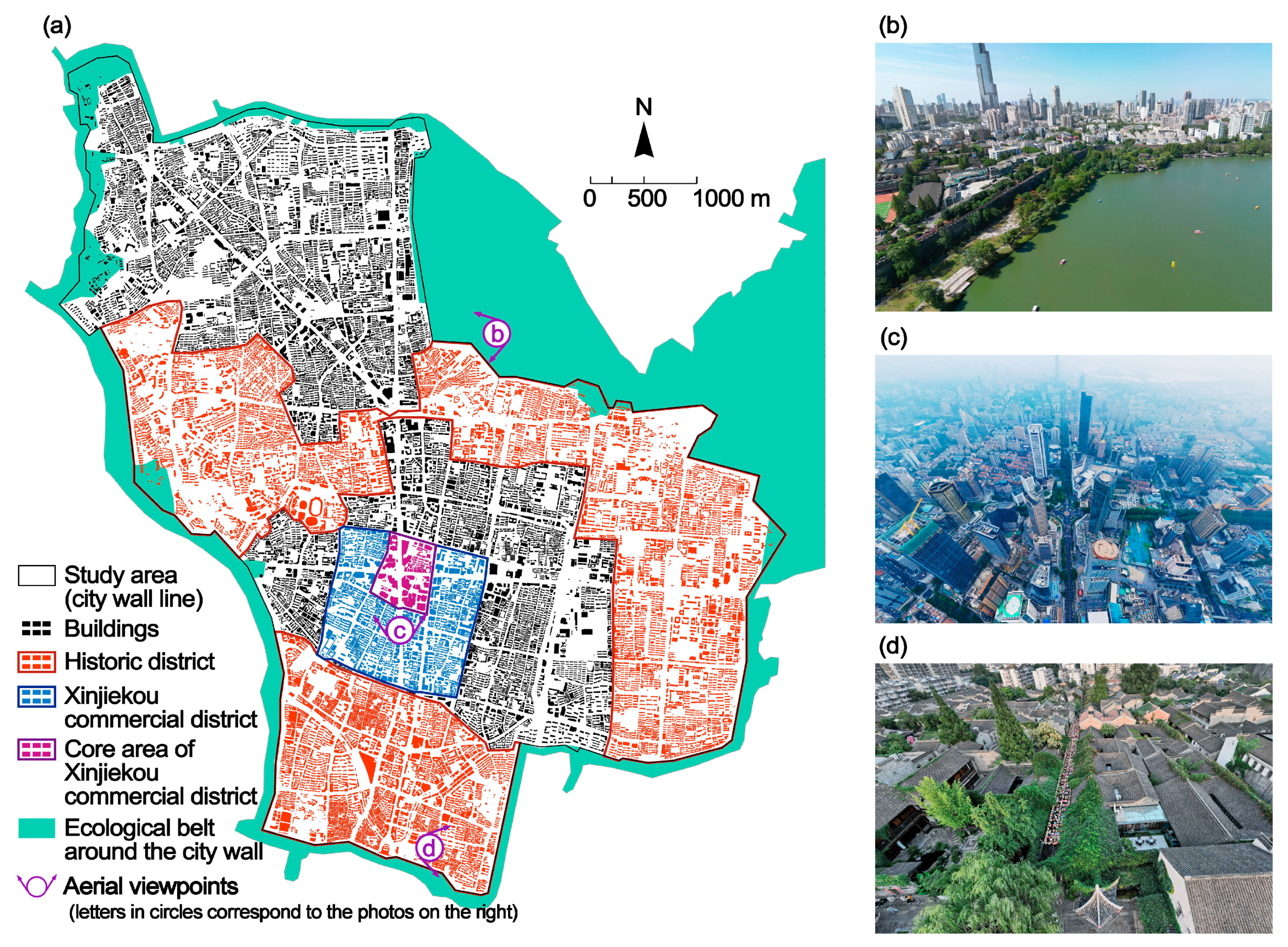
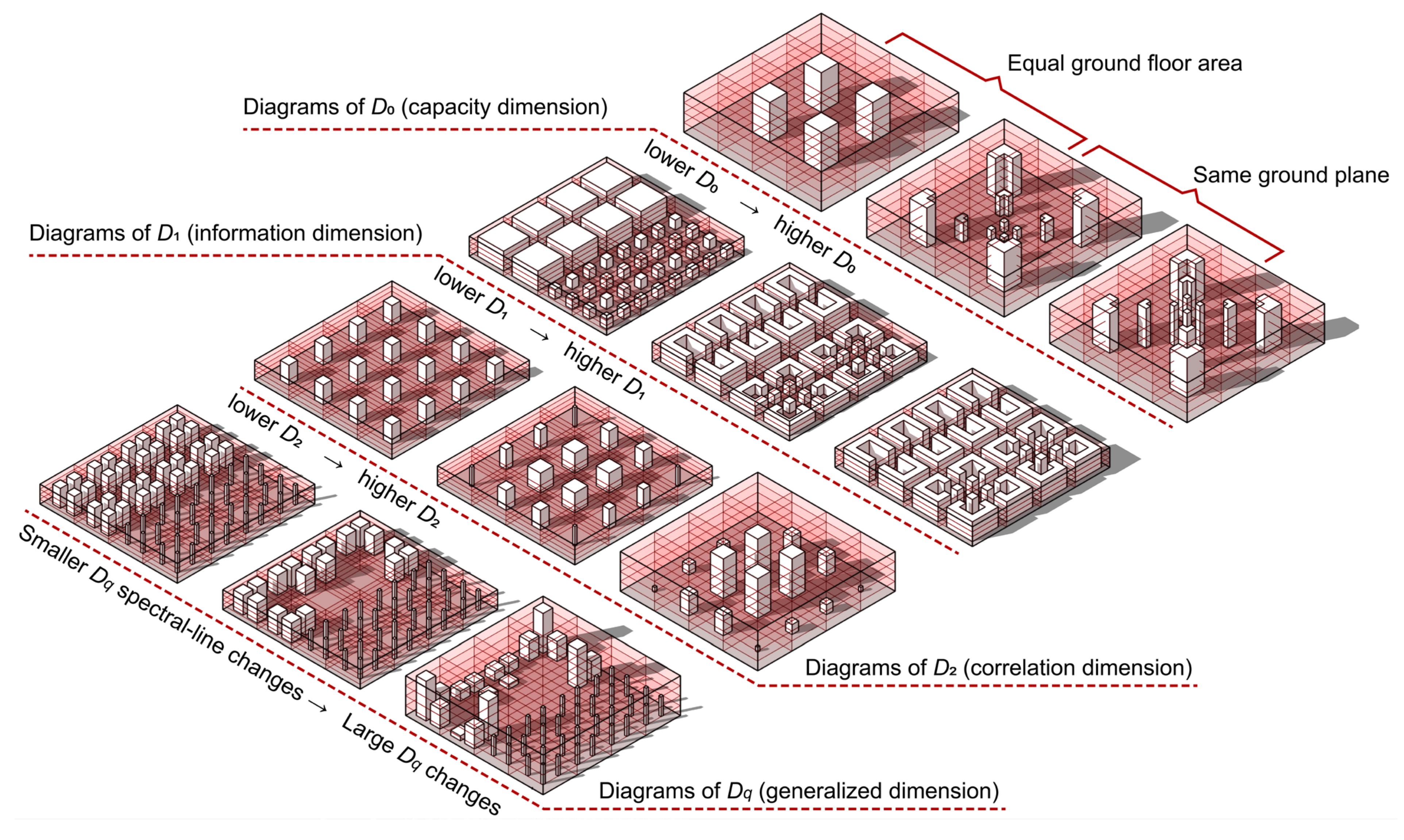

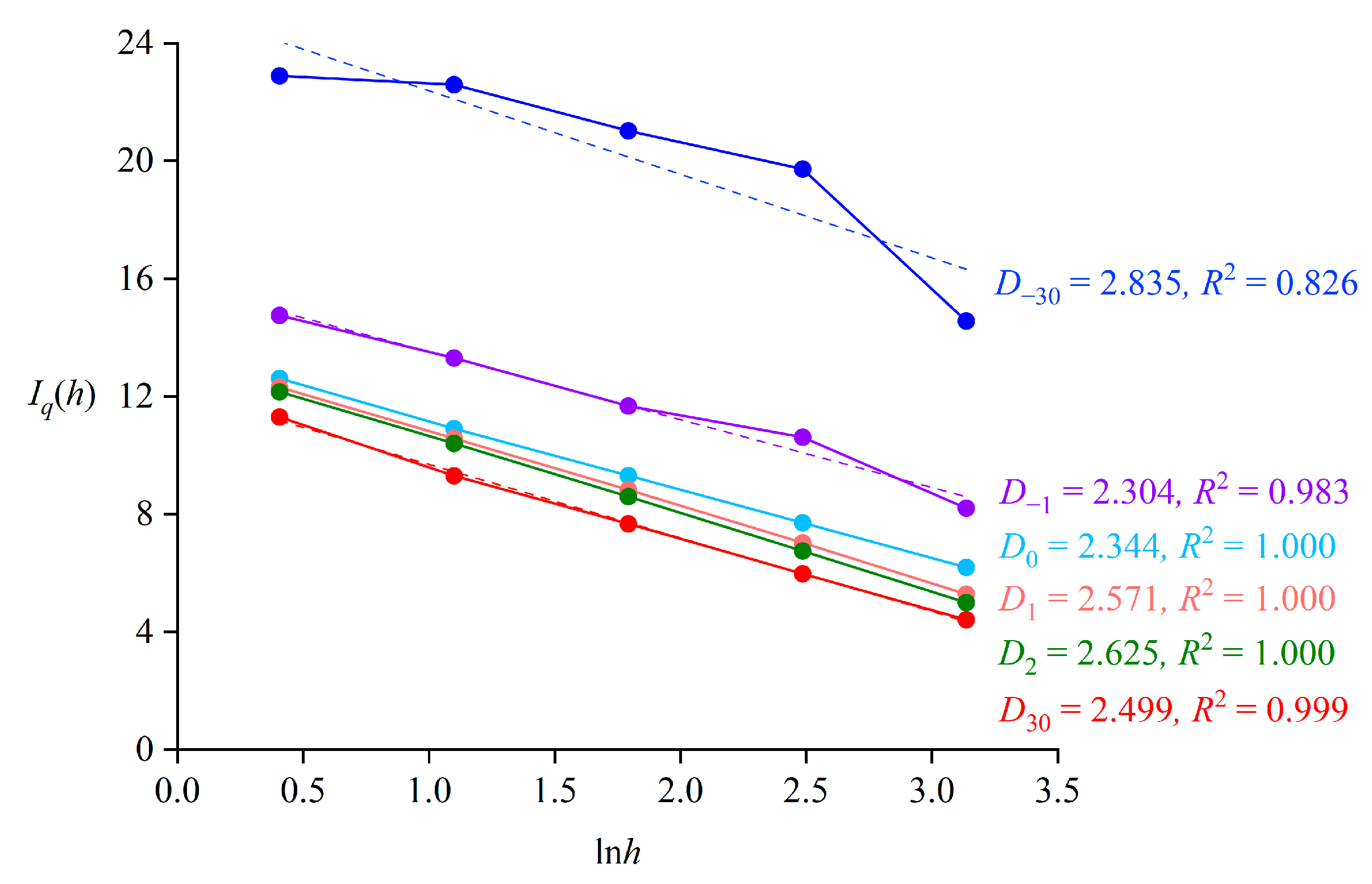
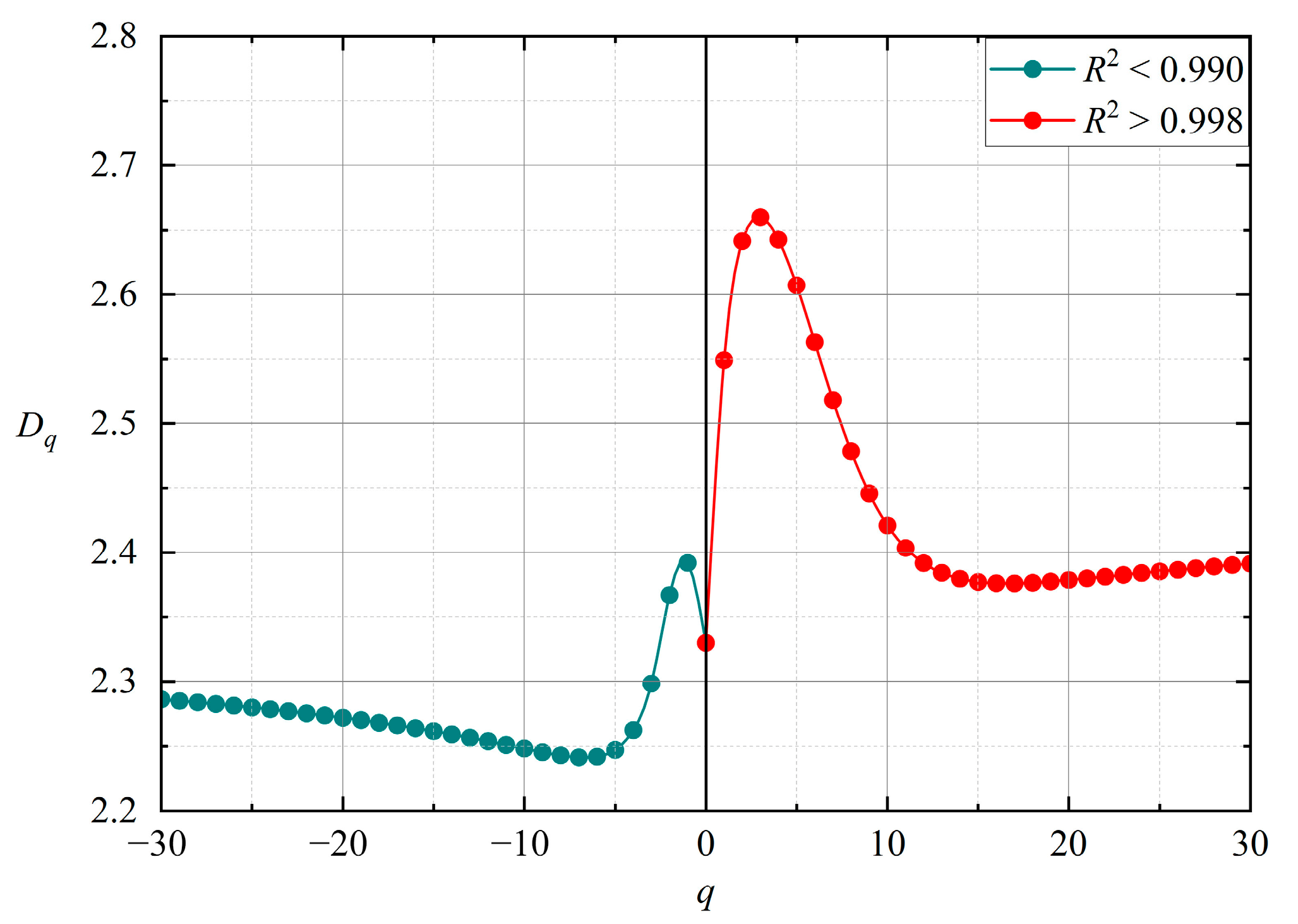
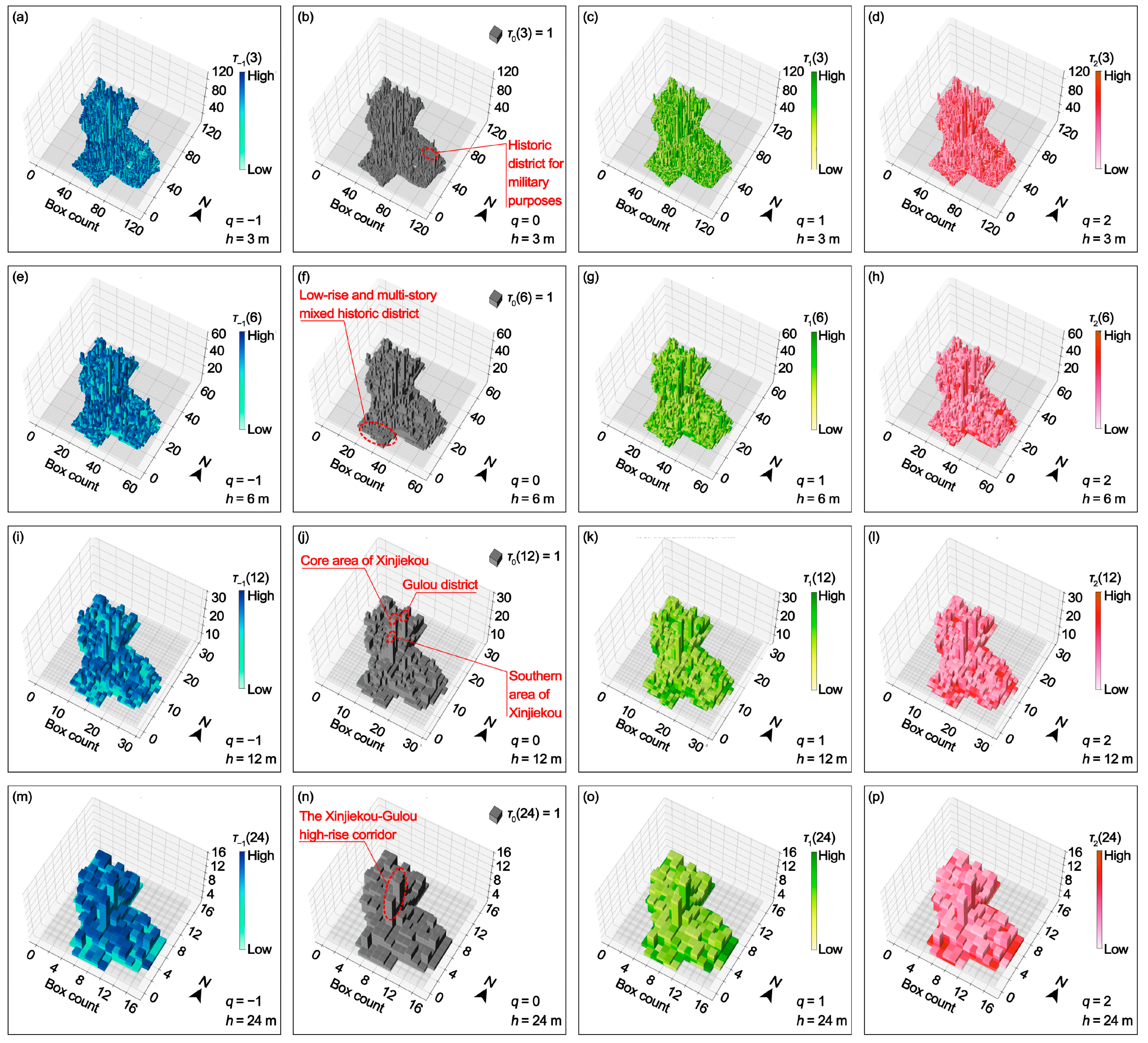

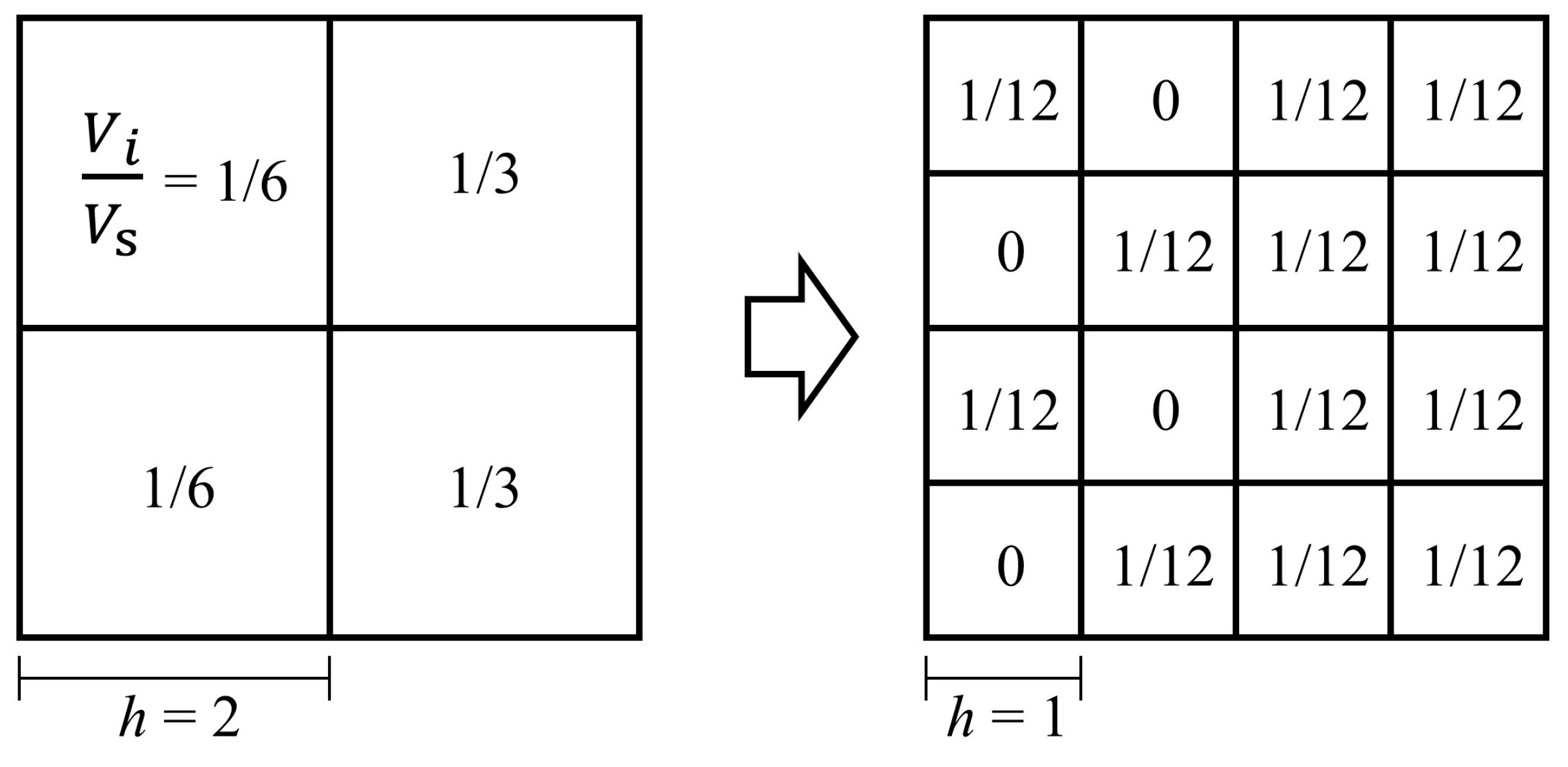

| e | x | y | h | N′ | N |
|---|---|---|---|---|---|
| 15 | 567.6 m | 655.8 m | 24.0 m | 3375 | 489 |
| 29 | 293.6 m | 339.2 m | 12.0 m | 24,389 | 2231 |
| 57 | 149.4 m | 172.6 m | 6.0 m | 185,193 | 11,086 |
| 113 | 75.3 m | 87.1 m | 3.0 m | 1,442,897 | 54,606 |
| 226 | 37.7 m | 43.5 m | 1.5 | 11,543,176 | 301,270 |
Disclaimer/Publisher’s Note: The statements, opinions and data contained in all publications are solely those of the individual author(s) and contributor(s) and not of MDPI and/or the editor(s). MDPI and/or the editor(s) disclaim responsibility for any injury to people or property resulting from any ideas, methods, instructions or products referred to in the content. |
© 2025 by the authors. Licensee MDPI, Basel, Switzerland. This article is an open access article distributed under the terms and conditions of the Creative Commons Attribution (CC BY) license (https://creativecommons.org/licenses/by/4.0/).
Share and Cite
Zhang, C.; Yang, J.; Liu, X.; Shao, D.; Zhang, Z.; Zhang, Z.; Sun, H.; Huang, Y.; Chen, D.; Zhang, X. The 3D Multifractal Characteristics of Urban Morphology in Chinese Old Districts. Fractal Fract. 2025, 9, 195. https://doi.org/10.3390/fractalfract9030195
Zhang C, Yang J, Liu X, Shao D, Zhang Z, Zhang Z, Sun H, Huang Y, Chen D, Zhang X. The 3D Multifractal Characteristics of Urban Morphology in Chinese Old Districts. Fractal and Fractional. 2025; 9(3):195. https://doi.org/10.3390/fractalfract9030195
Chicago/Turabian StyleZhang, Chenyang, Junyan Yang, Xinzhe Liu, Dian Shao, Zhonghu Zhang, Zhihan Zhang, Haocheng Sun, Yuyue Huang, Daijun Chen, and Xun Zhang. 2025. "The 3D Multifractal Characteristics of Urban Morphology in Chinese Old Districts" Fractal and Fractional 9, no. 3: 195. https://doi.org/10.3390/fractalfract9030195
APA StyleZhang, C., Yang, J., Liu, X., Shao, D., Zhang, Z., Zhang, Z., Sun, H., Huang, Y., Chen, D., & Zhang, X. (2025). The 3D Multifractal Characteristics of Urban Morphology in Chinese Old Districts. Fractal and Fractional, 9(3), 195. https://doi.org/10.3390/fractalfract9030195






